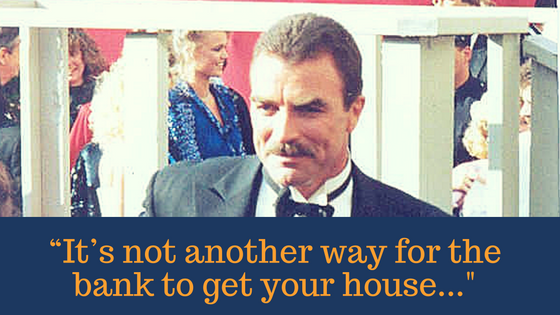As many readers may be aware, Reverse Mortgage loans are much more prevalent and established in United States than in Australia. So it can be a useful experience to look to the American market for comparisons and possible future trends that may emerge locally. To that end it’s interesting to see that the veteran actor Tom Selleck (Magnum, P.I. and Blue Blood) recently appeared in a TV commercial promoting reverse mortgages for an American mortgage lender.
Beyond the 71-year-old actor’s credible appeal, his pitch can be effective in convincing the market to use the equity locked in their homes so they can generate cash needed for retirement.
Reverse Mortgage: Too Good to be True?
“It’s not another way for the bank to get your house, and it’s also not too good to be true,” says Selleck in the TV commercial. Many American seniors may agree, but it is always best to apply a critical eye to any celebrity endorsement and instead explore the facts about the product being advertised – in this case reverse mortgages.
Although the U.S product differs in some key respects, through an Australian reverse mortgage you can access a credit line or a lump sum using your home as a security. However, you remain full registered owners of the property (the bank does not take control of your property) and you continue to live in your own home as long as you want. Some people think that this is “too good to be true”, because once they understand how reverse mortgages actually work many Australian seniors do indeed take the view that it’s a lot better than selling your home when you need cash.
The amount that you can borrow will depend on the value of your home, and your age. You can choose to access the fund in lump sum, in regular payments or credit line. And like any other financial products and services, there is fine print to review and below are top critical points you should understand:
- You still need to pay for property taxes, maintenance cost, and insurance.
- You may choose not to pay for the loan but the interest will be added to your balance each month, so the interest will compound over time.
- The loan should be settled first before you can move out or sell the property.
- The loan should be settled once both you and your spouse have passed away.
FACT: Reverse Mortgage is Not for Everyone
Just because you are already a senior and you own your home doesn’t automatically qualify you to get reverse mortgage.
You are an ideal candidate for a reverse mortgage loan if you have already paid off your mortgages before retirement (or there is a modest amount left owing which can be refinanced by the new reverse mortgage loan), you like where you live (no plans to move out), and you have a genuine need for more money to fund retirement.
You can choose to receive the loan proceeds as a lump sum if you need to finance large purchases to help you with your retirement, while a monthly payment is ideal if you need supplemental cash on top of your pension or superannuation. Meanwhile, if you just need to have a standby fund for emergency expenses, a line of credit (cash reserve) can be ideal.
Remember, reverse mortgage is a big financial decision, so you should do your due diligence first. Tom Selleck might have caught your attention, but be sure to understand this financial offer well. To help you learn more about reverse mortgage, you can download our FREE REVERSE MORTGAGE GUIDE.
You can also call Seniors First Finance at 1300 745 745 or post your comments below.
Regards, Darren
Photo credits: Alan Light, CC BY 2.0, https://commons.wikimedia.org/w/index.php?curid=1470255


